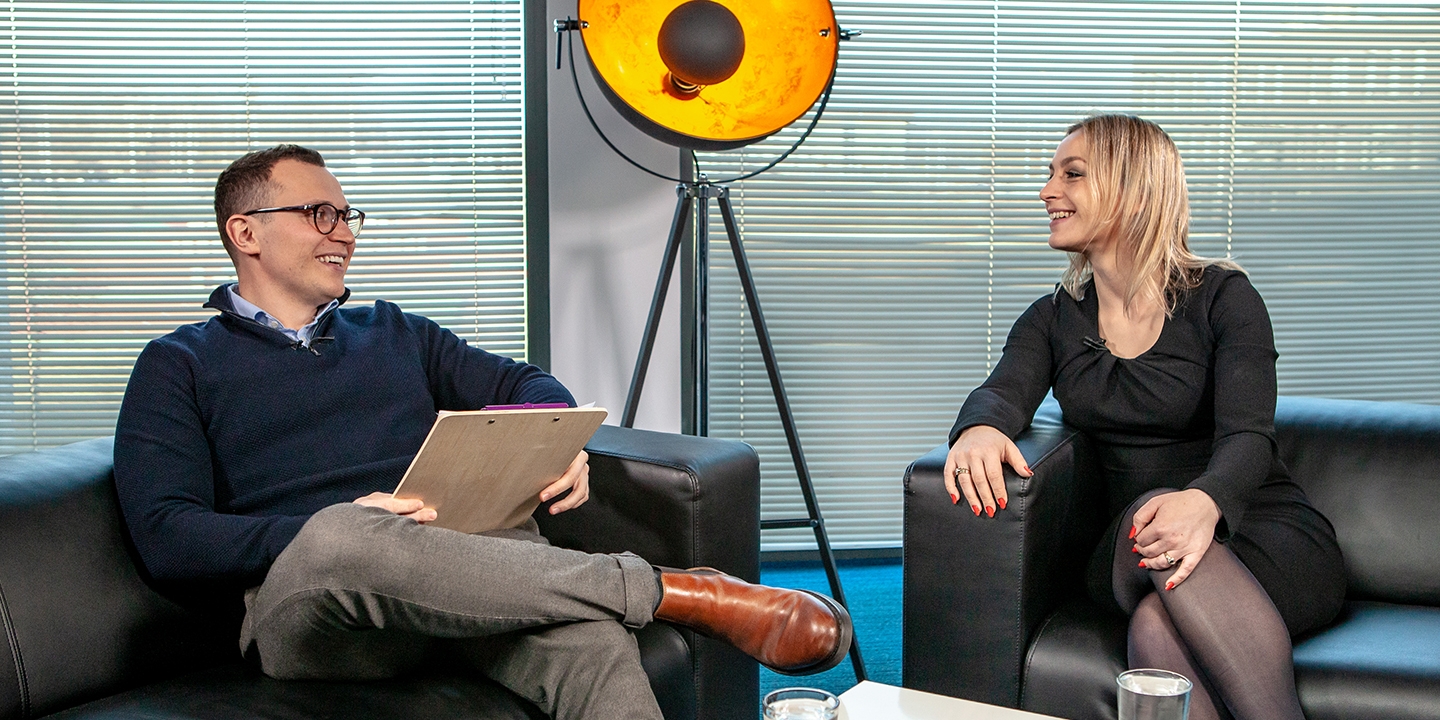- Insights hub
- /
- AI and NLP – use cases in...

AI and NLP – use cases in the Financial Services sector with Rob Cossins
- DetailsAbout the talks
- TranscriptTranscript
- Resources1 File
AI and NLP – use cases in the Financial Services sector with Rob Cossins
Michał Grela
Relationship Manager at Future Processing
In this conversation we’ll seek to highlight and demonstrate cutting edge AI tech that already disrupts the FinTech scene.
Hours are currently spent sifting through large amounts of textual and numerical data, either to make risk decisions or discover whether information on a particular client is held somewhere internally. No one’s really keen on doing the mundane, repeatable work and luckily, AI comes to the rescue.
New machine learning models allow for, among others, organisations within the Financial Sector to use NLP to quickly condense relevant information, from any source – from extensive due diligence down to internal credit research, supporting Risk Analysis and other important processes.
In this conversation we’ll seek to highlight and demonstrate cutting edge AI tech that already disrupts the FinTech scene.
Michał Grela (MG): Hello, and welcome to yet another episode of IT Insights by Future Processing. Today, my guest is Rob, and we’re going to talk about how AI and NLP supports risks analysis and other aspects of how the financial services sector is performing.
Hours are currently spent sifting through large amounts of data, either textual or numerical, to make perhaps decisions or to discover whether information or a particular client is held somewhere internally. But the challenge is that, of course, no-one’s really keen on doing the mundane repeatable work and well, luckily AI comes to the rescue and that’s going to be the topic of our conversation today.
New machine learning models allow for well, among others, organizations to quickly condense relevant information from any source, from extensive due diligence to credit research, supporting risk analysis and other important processes. So, in this conversation with Rob, we’ll seek to highlight and demonstrate cutting-edge AI tech that already disrupts the FinTech scene. Rob, I’m super happy to have you here today with me. If you could please introduce yourself and say a few words please.
Rob Cossins (RC): Sure. Happy to do so. Happy to speak. Thanks for the invitation again.
MG: Brilliant.
RC: So, my name’s Rob, I’m co-founder and CEO of Scribe. So my background, I spent many years in banking, specifically in risk management, and everything that we’re trying to do with Scribe is to bring academic research, so AI research, into financial services. Specifically to speed up some of those administrative processes that you currently have within large organizations. Yeah, that’s it.
MG: Cool. Looks like you have hands-on experience then in the topic.
RC: Exactly.
MG: Risk analysis is well … or the backbone of it is related to information discovery. What are the most common challenges when it comes to this field, to information discovery and its importance?
RC: Sure. So, I think the main aspect of this is really the amount of time that it takes to find fairly simple information. So, in order to make decisions within banks, let’s say, there’s a lot of information around it and it’s not so easy to get ahold of it. And this has a bit of an impact because it slows down overall processes and it has an impact on clients and their businesses as well. So, quite often, I used to see this all the time, information is sat across different teams, in different email inboxes, different folders, and this adds hours and hours and hours. I remember Q&A back and forth between various teams internally. So, it’s difficult to find, access, and analyze large volumes of information. And I suppose another thing to add to that is that the kind of information that banks are using to make decisions are very long. So, annual reports can often run into the three, 400 pages territory, due diligence reports are the same, commercial due diligence, legal due diligence. And also, the information is often private. For anybody that’s worked in finance will know that you can’t just type into a search engine to find things that you want, it doesn’t quite work like that, unfortunately, no.
MG: Well, no wonder, since banks are usually huge organizations, employing hundreds of thousands of employees all around the world. So, I imagine there’s plenty of silos and bottlenecks and information is just not available the way it should be. And as you mentioned, this discovery of this information or looking for a particular set of data is just mundane and today in 2020, there’s this really… I believe that with the technology we have, there’s no point in doing some sort of work manually. And I believe, and well, I know that AI is great for automating these mundane tasks, but there’s a long way from academia to the market. And although, we’re aware that there are some models that are already there, are built, are trained, et cetera there’s a long way for them to become used in practice. So, that’s my next question, what is the usual path they have to follow to become, or to start being used?
RC: Yeah, I mean, I’m obviously biased when I’m saying this, but I think there’s a big opportunity to exploit here for startups and also organizations themselves. I think for many years, academic models, particularly machine learning models, have been created primarily in isolation from industry. And so, that means that there’s a really, really big lead time between academic research being undertaken, different models being trained and tested before implementation in industry. So, I suppose a fairly obvious example is optical character recognition technology. So, being able to detect certain numbers or textual items in large amounts of data. I mean, this technology has been around for years, but it’s only really now being commercialized at scale. So, a simple example might be receipts or bank statements, all of that kind of stuff. So, I think academic research needs catalysts, to make a domain shift, so to solving real industry problems. And that’s where I think startups like ourselves come in and there are plenty of other people doing things like this. So, I mean, one other example that comes to mind, a very well known company in the AI space is Hugging Face. They’ve commoditized research by making this easier to access and applying it to fairly concrete use cases that industry people care about. And that’s something that we’re really focused on doing, taking models out of academic research and applying them to old problems within financial services.
MC: I believe that will be for the benefit of the whole financial services scene, for sure. And well, let’s make it another question then, what are the other perhaps use cases or how can the financial scene actually benefit from doing what you just described, from actually harnessing these models?
RC: I think that there are many, many cases and you only need to search very quickly on AI and finance and you’ll find a whole raft of information available on this. I think, in my view, we’re still really at the start, but I think that … I suppose breaking it down into two areas, firstly data, so organizations are making a much more concerted effort to organize and arrange all of the data that they hold. So, banks in particular are moving to cloud services, leveraging cloud technology, and that enables them to use their internal data in a much more clever way. The second point is, I suppose, the underlying models themselves are improving quite rapidly, particularly in research, but also in industry. And so, to give a few fairly concrete examples. So, machine learning models have been trained on Q&A datasets. So, you have a question, you tag it, that’s an answer. So, one particularly big dataset comes to mind is, is SQuAD1 and SQuAD2. This is the Stanford Question Answering Dataset. And so, this is still being developed actively, and there’s a long way to go to work through these datasets, but effectively what that means is that you can interrogate all of your available data. So, let’s take, a commercial due diligence for a company, 300 pages long, and you can ask it questions, say, “What happened in 2019 to staff costs?” For example, and you’ll be able to get a response and the accuracy on these responses is incredibly high. That has use cases right across the industry. And because the volume of training data is getting more and more and more, GPT-3 was in the news very recently, and that has quite a few interesting applications. I mean, a few come to mind, quick translation of company accounts, being able to generate sentiment analysis, inferring correlations with market signals from large volumes of texts. I mean, this has improved very significantly in a very short space of time. I think you still need that expertise to know which models to use in which scenarios and how to plug them to problems that are out there. But I think those are some of the opportunities, is they’re a little bit more immediate on how you can use recent advancements in artificial intelligence.
MG: That’s really super exciting and there’s this follow I have, having quite a lot of this sort of conversations, the conclusion I come to is that, of course the however sexy sometimes technology sounds, it sometimes might turn out that the use case for it is not as sexy as the technology itself. And I’m wondering if that’s not perhaps a thing in this field here again, whereas something or technology looks particularly interesting to leverage, but then it turns out that it’s actually not that use because it doesn’t have this use cases. Well, let’s see how it goes here, but on the way you described the model has to follow, there’s plenty of… Or the startup has to take this model through this way, through this path is, there’s this plenty of pitfalls to avoid. And I’m keen on understanding whether you have some sort of mistakes that come to your mind, that you could share your thoughts on what to avoid and how to do it right.
RC: Sure. I mean, I completely agree. I think that large organizations often get distracted by new technology, particularly AI, and there are plenty other buzzwords out there that I don’t need to name, that people do get, I would say distracted by. And I think, I mean, one example for me anyway, and there are a lot of people that would disagree with me on this is predictive analytics, in particular, these kind of things often fail to live up to expectations because we expect much more out of artificial intelligence than is possible. I think for us in particular, and this informs our thinking right across the business is that actually bigger opportunities lie in applying new machine learning models to old problems. To take the words that you used, unsexy problems, and I think quite often problems in large organizations can be solved by better use of very straightforward technology rather than maybe advanced AI. But I suppose, to answer in more of an AI direction, I think because some of these models have become so commoditized and they’ve become quite general purpose. And although, they’re extremely powerful, trained on large volumes of data, they’re not actually tailored to specific problems. So, what you really need to be doing is training research models to be relevant for industry use cases, in our case, that’s finance, but that could be healthcare, that could be logistics. So, because these models are quite general, you need something on top to make them applicable for industry, and that’s where the real magic happens, and I think that’s where things get really exciting. I think when people get a little bit distracted by some of the terminology, that’s when you can waste big volumes of time and resources.
MG: Well, that’s really to the point. And what would be your tips and predictions for the future? Where will industry go on this path? How would you imagine the financial services scene using AI in say, I don’t know, horizon five years.
RC: Sure. I’ve said to a lot of my friends, actually not many people agree with me on this, but I personally think there will be quite a big divergence in market capitalization and value of banks over the next five years. And the ones that apply technology and particularly some of these more advanced machine learning technologies, will win. So, there will be winners and losers. I think, I don’t want to risk turning this into a FinTech debate, but generally large established banks have balance sheets. So, that gives them a very well entrenched, competitive position that’s really hard to disrupt, frankly, overall. And so, I think they will be here. I think where the industry will go is more around augmenting human talent rather than replacing. Regulated organizations need to, and can work with explainable AI, but they can’t work with black box AI, it’s not something that the industry is comfortable with and can work with. And so, those that can implement technology appropriately, I think will realize big competitive advantages and that will accelerate market growth, both in terms of revenue, but also cost. Large global banks have big cost basis and those that can bring it down will have improved profitability. I suppose, more on the machine learning side, I think that training sets for some of these models is increasing almost exponentially and it’s getting very, very expensive to train some of these models. So, I think this trend towards increasing sizes of models, isn’t actually that sustainable. I think what we will see happening is that we will have an increase in the number of models that are created with knowledge distillation. So, where large models are used to teach smaller machine learning models, which will have the same performance, but for a fraction of the size. And I think that’s where we’ll see some of these larger models being made more bespoke to certain use cases. And that’s certainly where we see things going over the next five years, that’s from a technology perspective. From a financial services, I mean, that’s a whole world of podcasts that I’m sure we don’t need to get into.
MG: Yeah. Well, I believe that at the end of the day, we as everyday users of bank services and insurance services, will be on the, maybe not in the trenches, but on the frontline definitely of the change. I also believe that customer experience or the way banks treat customer experience, and will treat it in the upcoming years, is also perhaps a trend that AI can potentially disrupt. Let’s hope it’s going to be for the better.
RC: Yeah. And I think, I mean, the one thing I would add to that is the newer use of technology. There’s been a lot of focus on the markets, investment banking side, and also retail banks, the apps on your phone. I think the next wave of innovation in the sector will really be in this compliance risk, all of that sort of middle and back office activity. There are big, big improvements that you can make with both advanced technologies, but also straightforward use of existing technology.
MG: Right on. Thank you, Rob, that was a really interesting conversation. I believe we went quickly, but only through some sort of AI use cases and the way it disrupts and potentially will be disrupting continuously, the FS scene. Thank you for sharing your thoughts. It was a great to have you here.
RC: Thank you for having me.
MG: And thank you, our listeners, for being with us on this, another episode of IT Insights. Let us know if you liked it, and please do drop us a note if you’d like to have another topic covered in one of the future episodes. Thanks.
Contact
Get in touch
Have any question about specific material?
Let us know!








